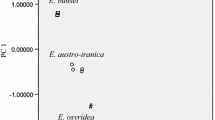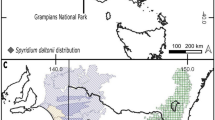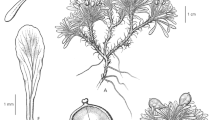Abstract
Fairy lanterns (Thismia Griff.) is a genus of poorly known mycoheterotrophic plants with unclear infrageneric classification. Commonly used approaches that utilize just a single or few traits in higher-level taxonomy lead to an apparently artificial system. In this contribution, four new species from Sarawak, northern Borneo, are described and illustrated. Thismia acuminata, T. laevis and T. nigra belong undoubtedly to section Sarcosiphon. Thismia viridistriata exhibits a high morphological variability with some individuals fitting section Scaphiophora based on the presence of a column on the top of the mitre, but otherwise perfectly matching the morphological characteristic of section Sarcosiphon. Five-locus (SSU, ITS, LSU, matR, atpA) phylogeny inference revealed paraphyly or polyphyly in the studied infrageneric taxa and showed that the importance of some traits traditionally used in Thismia taxonomy was overestimated. Most of the markers provide comparable phylogenetic signal; LSU performs best and is highly recommended for further phylogenetic studies. On the other hand, ITS is hypervariable and thus informative only within (sub)sections, as well as on intraspecific level, as proven in T. viridistriata with two distinct ITS (and also LSU and matR) alleles and two morphotypes within a small geographic area, which leads to an assumption of strong reproductive isolation even among nearby populations. For delimitation of species, the key trait appears to be the structure of the connective and any of the molecular markers used here.









Similar content being viewed by others
References
Bidartondo MI (2005) The evolutionary ecology of myco-heterotrophy. New Phytol 167:335–352. https://doi.org/10.1111/j.1469-8137.2005.01429.x
Blume CL (1850) Burmanniaceae. Mus Bot Lugduno-Batavum 1(5):65–80
Chantanaorrapint S, Suddee S (2018) Thismia thaithongiana (Dioscoreaceae: Thismieae), a new species of mycoheterotroph from an unusual habitat. Phytotaxa 333:287–292. https://doi.org/10.11646/phytotaxa.333.2.14
Chantanaorrapint S, Tetsana N, Sridith K (2015) Notes on Thismia clandestina (Thismiaceae), a little-known mycoheterotrophic species. Polish Bot J 60:71–74. https://doi.org/10.1515/pbj-2015-0013
Chantanaorrapint S, Wai JS, Poopath M, Tetsana N (2016) Thismia claviformis (Thismiaceae), a new species from the Thai-Malay Peninsula. Phytotaxa 280:292–296. https://doi.org/10.11646/phytotaxa.280.3.8
Chiang P-Y, Hsieh T-H (2011) Thismia huangii (Thismiaceae), a new species from Taiwan. Taiwania 56:138–142
Cooper WE (2017) Thismia hawkesii W.E.Cooper and T. lanternatus W.E.Cooper (Thismiaceae), two new fairy lantern species from the Wet Tropics Bioregion, Queensland, Australia. Austrobaileya 10:130–138
Dančák M, Hroneš M, Sochor M, Kobrlová L, Hédl R, Hrázský Z, Vildomcová A, Sukri RS, Metali F (2013) A new species of Thismia (Thismiaceae) from Brunei Darussalam, Borneo. Phytotaxa 125:33–39. https://doi.org/10.11646/phytotaxa.125.1.5
Darriba D, Taboada GL, Doallo RR, Posada D (2012) jModelTest 2: more models, new heuristics and parallel computing. Nat Meth 9:772. https://doi.org/10.1038/nmeth.2109
Doyle JJ, Doyle JL (1987) A rapid DNA isolation procedure for small quantities of fresh leaf tissue. Phytochem Bull 19:11–15
Eyre-Walker A, Gaut BS (1997) Correlated rates of synonymous site evolution across plant genomes. Molec Biol Evol 14:455–460. https://doi.org/10.1093/oxfordjournals.molbev.a025781
Govaerts R, Wilkin P, Saunders RM (2007) World checklist of Dioscoreales: yams and their allies. Royal Botanic Gardens, Kew
Hroneš M (2016) Genus Thismia Griff. (Thismiaceae) in Asia and Australasia with focus on the Malesian floristic region. Palacky University, Olomouc
Hroneš M, Kobrlová L, Taraška V, Popelka O, Hédl R, Sukri RS, Metali F, Dančák M (2015) Thismia brunneomitra, another new species of Thismia (Thismiaceae) from Ulu Temburong, Brunei Darussalam. Phytotaxa 234:172–178. https://doi.org/10.11646/phytotaxa.234.2.7
Hroneš M, Rejžek M, Sochor M, Svátek M, Kvasnica J, Egertová Z, Pereira JT, Nilus R, Dančák M (2018) Two new species of Thismia subsect. Odoardoa (Thismiaceae) from Borneo. Pl Ecol Evol (in press). https://doi.org/10.5091/plecevo.2018.1387
Hunt CA, Steenbeeke G, Merckx VSFT (2014) Thismia megalongensis (Thismiaceae), a new species of Thismia from New South Wales. Telopea 16:165–174. https://doi.org/10.7751/telopea20147809
Imhof S, Massicotte HB, Melville LH, Peterson RL (2013) Subterranean morphology and mycorrhizal structures. In: Merckx VSFT (ed) Mycoheterotrophy. Springer, New York, pp 157–214
IUCN (2012) and Criteria: version 3.1, 2nd edn. IUCN, Gland. Available at: http://www.iucnredlist.org/technical-documents/categories-and-criteria
Jarvie JK (1996) Thismia lauriana (Burmanniaceae), a new species from Central Kalimantan. Blumea 41:57–259
Jonker FP (1938) A monograph of the Burmanniaceae. Meded Bot Mus Herb Rijks Univ Utrecht 51:1–279
Jonker FP (1948) Burmanniaceae. In: van Steenis CGGJ (ed) Flora Malesiana I, 4. Noordhoff-Kolf, Leiden, pp 13–26
Kay KM, Sargent RD (2009) The role of animal pollination in plant speciation: integrating ecology, geography, and genetics. Annual Rev Ecol Evol Syst 40:637–656. https://doi.org/10.1146/annurev.ecolsys.110308.120310
Kiew R (1999) Thismia goodii (Burmanniaceae), the Blue-capped Thismia, a new species from Borneo. Gard Bull Singapore 51:179–182
Kovarik A, Pires JC, Leitch AR, Lim KY, Sherwood AM, Matyasek R, Rocca J, Soltis DE, Soltis PS (2005) Rapid concerted evolution of nuclear ribosomal DNA in two Tragopogon allopolyploids of recent and recurrent origin. Genetics 169:931–944. https://doi.org/10.1534/genetics.104.032839
Kumar P, Gale SW, Li J, Bouamanivong S, Fischer GA (2017) Thismia nigricoronata, a new species of Burmanniaceae (Thismieae, Dioscoreales) from Vang Vieng, Vientiane Province, Laos, and a key to subgeneric classification. Phytotaxa 319:225–240. https://doi.org/10.11646/phytotaxa.319.3.2
Kuzoff RK, Sweere JA, Soltis DE, Soltis PS, Zimmer EA (1998) The phylogenetic potential of entire 26S rDNA sequences in plants. Molec Biol Evol 15:251–263. https://doi.org/10.1093/oxfordjournals.molbev.a025922
Lanfear R, Frandsen PB, Wright AM et al (2017) PartitionFinder 2: new methods for selecting partitioned models of evolution for molecular and morphological phylogenetic analyses. Molec Biol Evol 34:772–773. https://doi.org/10.1093/molbev/msw260
Maas PJM, Maas-van de Kamer H, van Benthem J, Snelders HCM, Rübsamen T (1986) Burmanniaceae. Fl Neotrop Monogr 42:1–189
Mar SS, Saunders R (2015) Thismia hongkongensis (Thismiaceae): a new mycoheterotrophic species from Hong Kong, China, with observations on floral visitors and seed dispersal. PhytoKeys 46:21–33. https://doi.org/10.3897/phytokeys.46.8963
Meng S-W, Chen Z-D, Li D-Z, Liang H-X (2002) Phylogeny of Saururaceae based on mitochondrial matR gene sequence data. J Pl Res 115:71–76. https://doi.org/10.1007/s102650200011
Merckx VSFT, Schols P, Maas-van de Kamer H, Maas P, Huysmans S, Smets E (2006) Phylogeny and evolution of Burmanniaceae (Dioscoreales) based on nuclear and mitochondrial data. Amer J Bot 93:1684–1698
Merckx VSFT, Janssens SB, Hynson NA et al (2012) Mycoheterotrophic interactions are not limited to a narrow phylogenetic range of arbuscular mycorrhizal fungi. Molec Ecol 21:1524–1532. https://doi.org/10.1111/j.1365-294X.2012.05472.x
Merckx VSFT, Freudenstein JV, Kissling J, Christenhusz MJM, Stotler RE, Crandall-Stotler B, Wickett N, Rudall PJ, Maas-van de Kamer H, Maas PJM (2013a) Taxonomy and classification. In: Merckx VSFT (ed) Mycoheterotrophy. Springer, New York, pp 19–101
Merckx VSFT, Smets EF, Specht CD (2013b) Biogeography and conservation. In: Merckx VSFT (ed) Mycoheterotrophy. Springer, New York, pp 103–156
Merckx VSFT, Gomes SIF, Wapstra M, Hunt C, Steenbeeke G, Mennes CB, Walsh N, Smissen R, Hsieh TH, Smets Bidartondo MI (2017) The biogeographical history of the interaction between mycoheterotrophic Thismia (Thismiaceae) plants and mycorrhizal Rhizophagus (Glomeraceae) fungi. J Biogeogr 44:1869–1879. https://doi.org/10.1111/jbi.12994
Ronquist F, Teslenko M, van der Mark P, Ayres DL, Darling A, Hohna S, Larget B, Liu L, Suchard MA, Huelsenbeck JP (2012) MrBayes 3.2: efficient Bayesian phylogenetic inference and model choice across a large model space. Syst Biol 61:539–542. https://doi.org/10.1093/sysbio/sys029
Schlechter FRR (1921) Die Thismieae. Notizbl Königl Bot Gart Berlin 8:31–45
Smith JJ (1911) Beiträge zur Kenntnis der Saprophyten Javas. IV. Zur Systematik von Thismia clandestina Miq. und Thismia Versteegii J. J. Smith. Ann Jard Bot Buitenzorg 24:55–59
Sochor M, Vašut RJ, Sharbel TF, Trávníček B (2015) How just a few makes a lot: speciation via reticulation and apomixis on example of European brambles (Rubus subgen. Rubus, Rosaceae). Molec Phylogen Evol 89:13–27. https://doi.org/10.1016/j.ympev.2015.04.007
Sochor M, Sukri RS, Metali F, Dančák M (2017) Thismia inconspicua (Thismiaceae), a new mycoheterotrophic species from Borneo. Phytotaxa 295:263–270. https://doi.org/10.11646/phytotaxa.295.3.7
Suetsugu K, Tsukaya H, Tagane S, Suddee S, Rueangruea S, Yahara T (2017) Thismia brunneomitroides (Thismiaceae), a new mycoheterotrophic species from southern Thailand. Phytotaxa 314:103–109. https://doi.org/10.11646/phytotaxa.314.1.9
Suetsugu K, Tsukaya H, Tagane S et al (2018) Flora of Bokor National Park VII: Thismia bokorensis (Burmanniaceae), a new species representing a new generic record. Phytotaxa 334:65–69. https://doi.org/10.11646/phytotaxa.334.1.10
Sujanapal P, Robi AJ, Dantas KJ, Sumod M, Merckx VSFT (2017) Thismia (Thismiaceae): the first record of the mycoheterotrophic genus to the Flora of India with a new species revealing the phytogeographical significance of Western Ghats. Blumea 62:97–102. https://doi.org/10.3767/blumea.2017.62.2.04
Tamura K, Peterson D, Peterson N, Stecher G, Nei M, Kumar S (2011) MEGA5: molecular evolutionary genetics analysis using maximum likelihood, evolutionary distance, and maximum parsimony methods. Molec Biol Evol 28:2731–2739. https://doi.org/10.1093/molbev/msr121
Tsukaya H, Okada H (2012) A new species of Thismia (Thismiaceae) from West Kalimantan, Borneo. Syst Bot 37:53–57. https://doi.org/10.1600/036364412X616639
Tsukaya H, Suleiman M, Okada H (2014) A new variety of Thismia hexagona Dančák, Hroneš, Koblová et Sochor (Thismiaceae) from Sabah, Borneo, Malaysia. Acta Phytotaxon Geobot 65:141–145
Tsukaya H, Suetsugu K, Suleiman M (2017) Thismia bryndonii (Thismiaceae), a new species from Maliau Basin, Sabah, Borneo. Phytotaxa 312:135–138. https://doi.org/10.11646/phytotaxa.312.1.13
White TJ, Bruns T, Lee S, Taylor JW (1990) Amplification and direct sequencing of fungal ribosomal RNA genes for phylogenetics. In: Innis MA, Gelfand DH, Sninsky JJ, White TJ (eds) PCR protocols: a guide to methods and applications. Academic Press, New York, pp 315–322
Acknowledgements
We thank John Rian Pasan and David Attu for guiding services, Nur Afiza Binti Umar (Sarawak Forestry Department) for providing us with all the permits, Zuzana Egertová for field assistance and staff of SAR herbarium, particularly Nur Safinas Binti Jelani, for kind cooperation. We are also grateful to Renata Melichárková for line drawings. MH was supported by the project no. IGA PrF-2018-001 from the Internal Grant Agency of the Palacký University, and MS was supported by Grant No. LO1204 (Sustainable development of research in the Centre of the Region Haná) from the National Program of Sustainability I, MEYS. The research was conducted under the permit No. NCCD.907.4.4(JLD.13)-337 issued by Sarawak Forestry Department.
Author information
Authors and Affiliations
Corresponding author
Ethics declarations
Conflict of interest
The authors declare that they have no conflict of interest.
Additional information
Handling editor: Christian Parisod.
Electronic supplementary material
Below is the link to the electronic supplementary material.
Information on Electronic Supplementary Material
Information on Electronic Supplementary Material
Online Resource 1. List of genbank accessions used in phylogeny reconstruction, list of specimens used for molecular analyses with collection data and alleles detected at each locus, and a map of collections.
Online Resource 2. Pairwise genetic distance among alleles detected in the reduced sample set.
Online Resource 3. Phylogenetic trees computed from each locus separately and supplementary trees from multilocus data.
Online Resource 4. Sequence alignments used for the analyses.
Rights and permissions
About this article
Cite this article
Sochor, M., Hroneš, M. & Dančák, M. New insights into variation, evolution and taxonomy of fairy lanterns (Thismia, Thismiaceae) with four new species from Borneo. Plant Syst Evol 304, 699–721 (2018). https://doi.org/10.1007/s00606-018-1504-5
Received:
Accepted:
Published:
Issue Date:
DOI: https://doi.org/10.1007/s00606-018-1504-5




